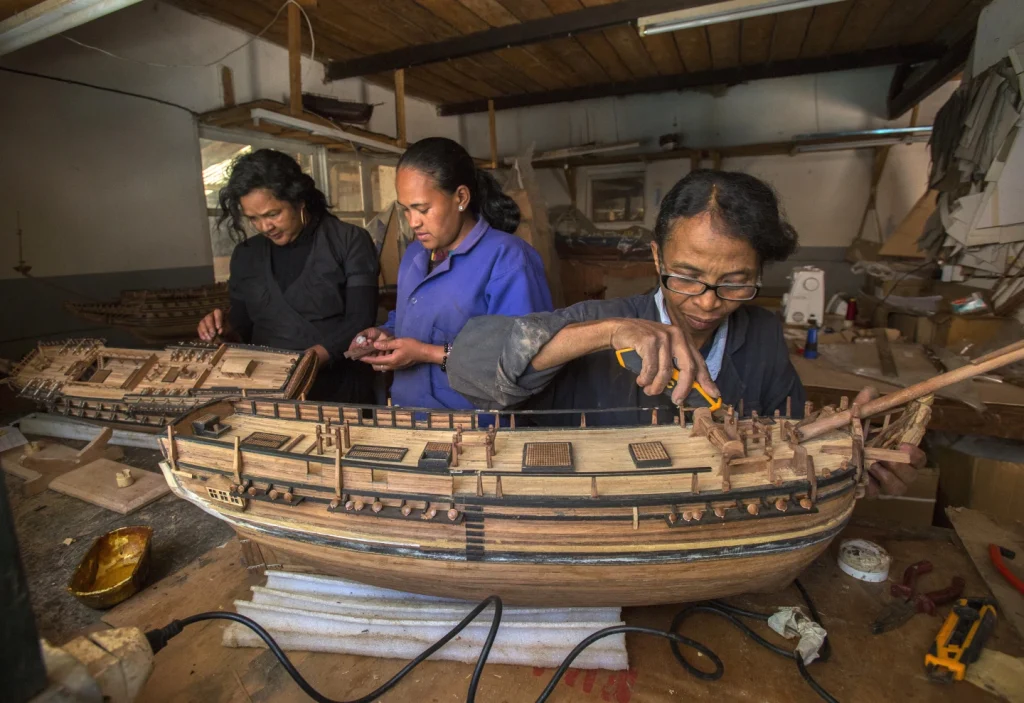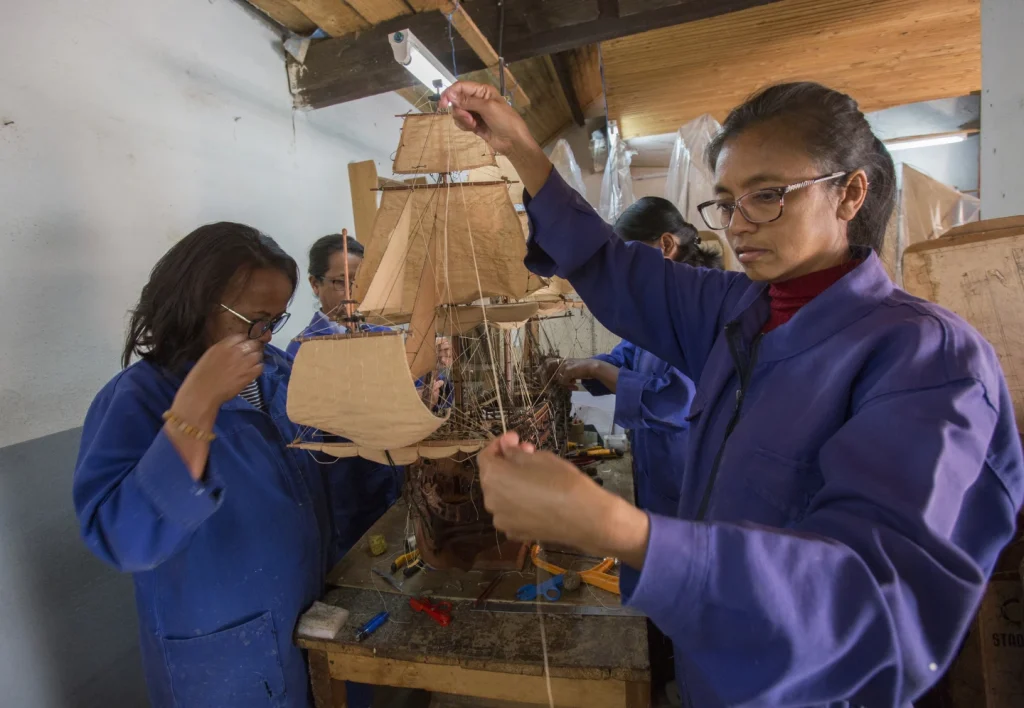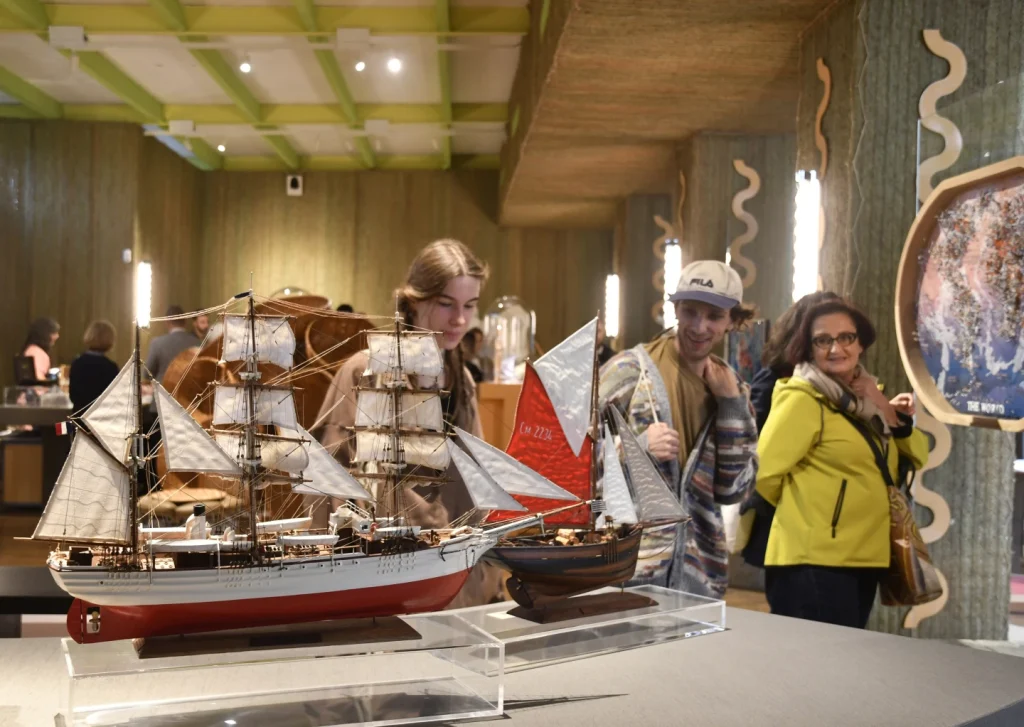In the bustling capital of Antananarivo, Madagascar, a remarkable endeavor unfolds within the modest settings of the Le Village model ship-making company. Here, history is not merely recounted through words but recreated with meticulous precision and unwavering dedication.
A significant highlight of this initiative is the revival of the Soleil d’Orient—an illustrious French trading ship that met its tragic fate in the 17th century.
As craftsman Rafah Ralahy diligently sands the rough wooden edges of a new model, he embodies the profound connection between craftsmanship and history, illuminating the spirit of perseverance and cultural preservation that defines this unique enterprise.
Rafah Ralahy, a seasoned craftsman with three decades of experience, stands at the helm of this painstaking process. His work on the model of the Soleil d’Orient is not merely a job; it is a passion that requires patience and an unwavering commitment to detail.
Ralahy’s eyes sparkle with the fervor of a dedicated artisan as he recounts the significance of reproducing the ship’s hull according to the original specifications. “
My job is to be as faithful as possible to the plan,” he explains, emphasizing the importance of historical accuracy. This meticulous approach ensures that each model produced at Le Village is not just a decorative piece, but a faithful reproduction of maritime history, crafted with love and precision.
The story of the Soleil d’Orient is steeped in historical significance. A vessel belonging to the French East India Company, it sank in 1681 while ferrying esteemed ambassadors and priceless treasures intended for King Louis XIV from Siam (modern-day Thailand).
The loss of this grand ship and its precious cargo serves as a poignant reminder of the fragility of maritime endeavors during that era.
By recreating the Soleil d’Orient, Ralahy and his colleagues perpetuate a legacy that transcends time, ensuring that the tale of the ship and its tragic fate remains alive in the present day.
Founded in 1993, Le Village has established itself as a beacon of craftsmanship in a region that historically lacks a robust shipbuilding tradition, despite being the fourth largest island in the world.
Its inception can be traced back to Frenchman Hervé Scrive, who fostered a passion for model shipbuilding upon his arrival in Madagascar.
Over the years, the company has survived numerous challenges, including a daunting economic decline exacerbated by the COVID-19 pandemic.
In the face of adversity, new ownership has infused fresh vigor into Le Village, aiming to create opportunities not only for themselves but for the community at large.
Grégory Postel, one of the new co-owners, speaks eloquently about the direction in which he and his partners hope to take the company.
Their ambitions extend beyond mere profitability; they aspire to establish a woodworking school—a significant move that could empower local artisans and preserve traditional craftsmanship in Madagascar.
Such initiatives could transform the socio-economic landscape of the region, offering practical skills and enhancing employment opportunities in a country afflicted by high poverty levels.
Le Village currently boasts a dedicated workforce of over two dozen artisans, many of whom have honed their skills over the course of 20 years or more.
In this unique workshop environment, collaboration is key; pairs of husbands and wives often work together, weaving their familial bonds into each piece they create.
This intergenerational transfer of skills and knowledge not only strengthens the craftsmanship present at Le Village but also fosters a sense of community and shared purpose among the artisans.
Each model undergoes a carefully orchestrated process as it moves through the different workshops, passing sequentially through the hands of specialists proficient in various aspects of model making—from ship crafting to intricate detail work.
The diligence of these workers culminates in an impressive final product. As Ralahy continues to shape the model of the Soleil d’Orient, he recognizes that some creations demand over 1,000 hours of devoted craftsmanship.
This dedication to detail has garnered Le Village a discerning clientele, including members of royal families in Spain and Monaco, who seek models reminiscent of the vessels their ancestors once sailed.
In a world increasingly disconnected from its maritime heritage, the work being done at Le Village serves not only as a bridge to the past but also as an opportunity for introspection.
The meticulous recreations of ships such as the Soleil d’Orient, the HMS Bounty, and even the Titanic encapsulate stories of human ambition, tragedy, and resilience.
By reviving these narratives in miniature form, Le Village contributes significantly to the understanding and appreciation of maritime history, allowing collectors and enthusiasts to revel in their own connections to these historical vessels.

The ambition to create a maritime museum, as envisaged by Postel and his partners, could further solidify Le Village’s role as a custodian of maritime heritage.
Such a museum could showcase the models and the rich cultural histories they represent, providing both educational insights and a space for communal engagement.
In doing so, Le Village would not only celebrate its own craft but also enlighten others about the broader historical contexts that shaped Madagascar’s connections to the sea.
In an adjacent workspace, four dedicated artisans are engaged in the meticulous crafting and attachment of the minuscule ropes, intricately designed sails, and various finishing touches that will complete a model ship, which is approaching its final stages of assembly.
This particular vessel, having already garnered the financial investment of its future owner, is being worked on with an acute sense of urgency, underscoring the artistry and precision required in this endeavor.
“It’s a race,” remarked Alexandria Mandimbiherimamisoa, as she prepared a series of miniature flags to adorn the ship, emphasizing the looming deadline: “We must send the boat to its buyer within a week.”
Joining her in this intricate work is her husband, Tovo-Hery Andrianarivo, whose hands bear the telltale marks of his craft—fingernails stained black from years of labor, a testament to countless hammer strikes gone awry, a frequent hazard within the trades.
With palpable pride, he reflected on the journeys undertaken by their creations, sharing anecdotes about the far-reaching destinations their models have reached across the globe.
His enthusiasm was particularly evident when he recounted the experience of watching a documentary focused on the reconstruction of the Hermione, an 18th-century frigate famously known for transporting French General Lafayette during the American War of Independence.
The vessel, meticulously rebuilt and launched to great acclaim in 2014, captured his attention; he noted with awe, “Behind the museum curator who was speaking, there was our model,” encapsulating the profound sense of accomplishment and connection he felt in that moment.
“The feeling I felt that day was incredible,” Andrianarivo concluded, a sentiment that speaks to the passion and dedication infused into each crafted piece that transcends mere artistry to become a vessel of history and pride.

In Antananarivo, the Le Village model ship-making company stands as a testament to the intersection of artistry, history, and community spirit.
Through the meticulous work of craftsmen like Rafah Ralahy, the stories encapsulated within each model continue to resonate, reminding us of the interconnected narratives that define our world.
By embracing both the challenges and the opportunities inherent in their craft, Le Village not only revives treasures of the past but also shapes a brighter, more inclusive future for aspiring artisans in Madagascar. In this endeavor, they celebrate not just the vessels they recreate, but the enduring spirit of human creativity and collaboration that transcends time itself.
